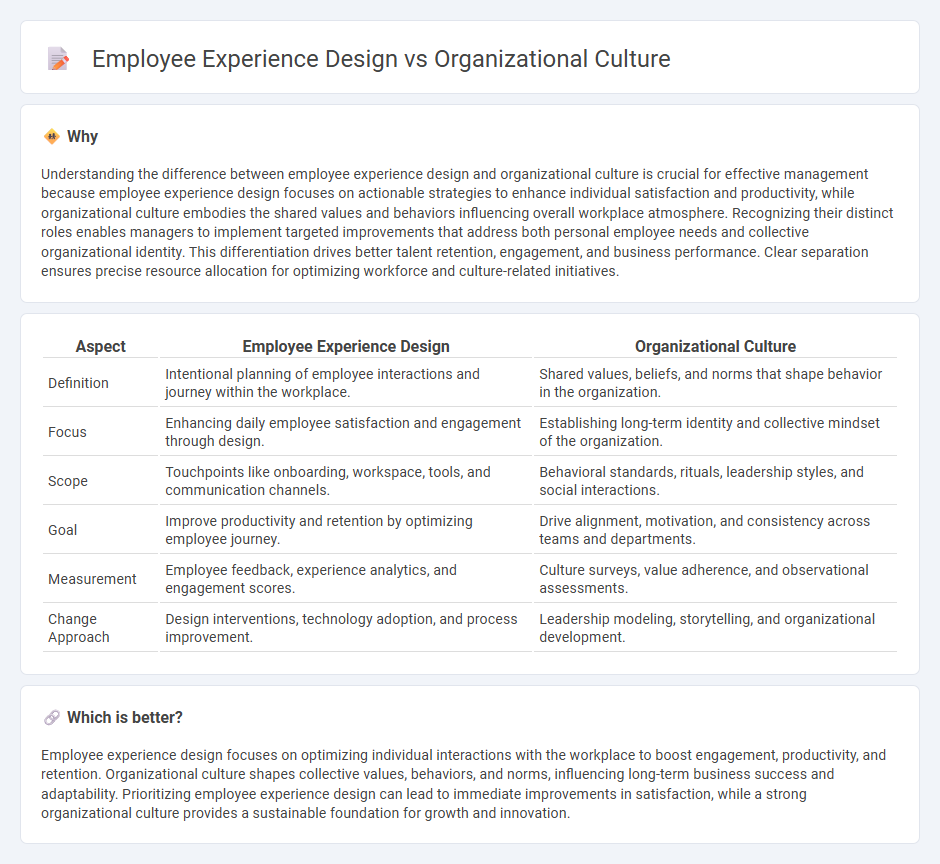
Employee experience design focuses on creating personalized and engaging touchpoints throughout the employee lifecycle to enhance satisfaction and productivity. Organizational culture emphasizes shared values, beliefs, and behaviors that shape the work environment and influence collective performance. Explore how aligning employee experience design with organizational culture can drive business success and workforce commitment.
Why it is important
Understanding the difference between employee experience design and organizational culture is crucial for effective management because employee experience design focuses on actionable strategies to enhance individual satisfaction and productivity, while organizational culture embodies the shared values and behaviors influencing overall workplace atmosphere. Recognizing their distinct roles enables managers to implement targeted improvements that address both personal employee needs and collective organizational identity. This differentiation drives better talent retention, engagement, and business performance. Clear separation ensures precise resource allocation for optimizing workforce and culture-related initiatives.
Comparison Table
| Aspect | Employee Experience Design | Organizational Culture |
|---|---|---|
| Definition | Intentional planning of employee interactions and journey within the workplace. | Shared values, beliefs, and norms that shape behavior in the organization. |
| Focus | Enhancing daily employee satisfaction and engagement through design. | Establishing long-term identity and collective mindset of the organization. |
| Scope | Touchpoints like onboarding, workspace, tools, and communication channels. | Behavioral standards, rituals, leadership styles, and social interactions. |
| Goal | Improve productivity and retention by optimizing employee journey. | Drive alignment, motivation, and consistency across teams and departments. |
| Measurement | Employee feedback, experience analytics, and engagement scores. | Culture surveys, value adherence, and observational assessments. |
| Change Approach | Design interventions, technology adoption, and process improvement. | Leadership modeling, storytelling, and organizational development. |
Which is better?
Employee experience design focuses on optimizing individual interactions with the workplace to boost engagement, productivity, and retention. Organizational culture shapes collective values, behaviors, and norms, influencing long-term business success and adaptability. Prioritizing employee experience design can lead to immediate improvements in satisfaction, while a strong organizational culture provides a sustainable foundation for growth and innovation.
Connection
Employee experience design directly influences organizational culture by shaping workplace interactions, values, and behaviors through tailored environments and processes. A positive employee experience fosters engagement, productivity, and alignment with company mission, reinforcing a strong, adaptive culture. Organizations prioritizing seamless experience design achieve higher retention rates and drive cultural transformation aligned with strategic goals.
Key Terms
Values Alignment
Organizational culture centers on shared values and beliefs that shape employee behavior and workplace climate, ensuring alignment with the company's mission. Employee experience design strategically crafts touchpoints and interactions to foster engagement, satisfaction, and alignment with those core values. Discover how integrating values alignment can enhance both organizational culture and employee experience design for stronger workforce cohesion.
Engagement Strategies
Organizational culture embodies the shared values, beliefs, and norms influencing employee behavior, while employee experience design strategically shapes interactions and environments to boost engagement and satisfaction. Effective engagement strategies align culture with design, fostering motivation, collaboration, and well-being through tailored communication, recognition programs, and feedback mechanisms. Explore how integrating organizational culture with employee experience design can transform workforce engagement and drive productivity.
Workplace Environment
Organizational culture shapes the core values, behaviors, and social norms within a workplace, influencing how employees interact and collaborate, while employee experience design focuses on creating tailored environments that enhance comfort, engagement, and productivity through strategic workspace layout, technology integration, and amenities. Both elements are crucial for fostering a positive workplace environment that supports employee well-being and performance, with organizational culture setting the tone and employee experience design providing practical implementation. Discover how aligning these factors can transform your workplace environment.
Source and External Links
Organizational Culture: Definition, Importance, and Development - This article defines organizational culture as a set of values, beliefs, and systems influencing employee behavior, and outlines its importance and development within organizations.
Organizational Culture: Definition and Types - This webpage explains organizational culture as shared values and practices, highlighting four main types: clan, adhocracy, market, and hierarchy cultures derived from the Competing Values Framework.
How Does Leadership Influence Organizational Culture? - This article discusses how leadership shapes organizational culture by aligning everyone with the organization's mission and vision, impacting employee behavior and business success.
 dowidth.com
dowidth.com